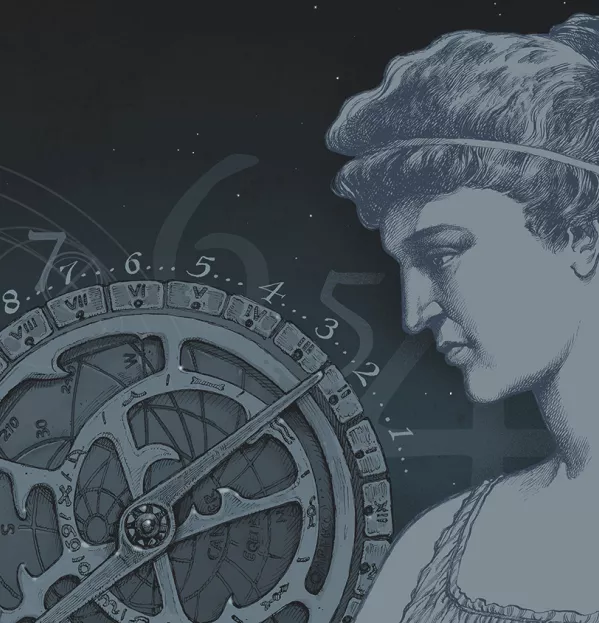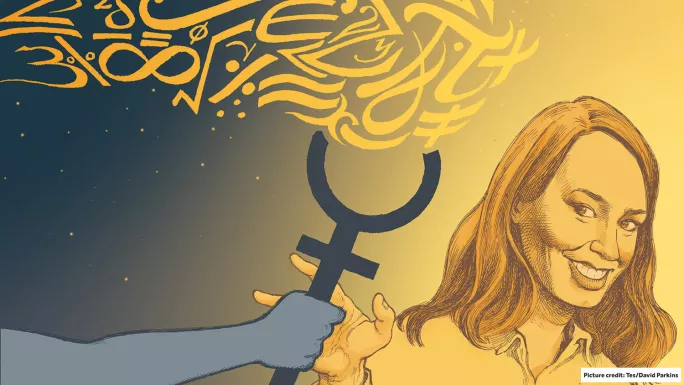
Countdown to equality...

The future of women in mathematics: on the up, surely? A-level maths entries are reasonably balanced, now (as long as we don’t talk about A-level further maths - shhhh). Plus, it’s been a great year for the visibility of women’s voices and activism. We’ve pretty much solved sexism, right? And it stands to reason that women doing mathematics, as they progress through their careers, are getting a better deal. Sexism is on the wane, its line on the graph trending downwards as women’s confidence and expertise at calling it out trends correspondingly upwards. That point of intersection is no mere crossing of two pencil marks, but a long-overdue transition of power.
Or at least I’d like to think that’s case. The successful and high profile initiatives I’ve seen promoted on social media are doing much to buoy my confidence. But I’m part of an international group of women - called “Tenure, she wrote” - whose experience in the field suggests otherwise. The following is from an online essay called “Leveling up: does sexism get worse as you advance?”
“One of the things that’s been striking to me in recent years is that, as I’ve gotten more successful and stable in my career advancement, I’ve experienced more sexism, not less.
“Other women in my male-dominated department have had similar experiences, I’ve learned. The friendliness turns to paternalism, which turns to hostility. The more successful you are, the more threatening.
“I’ve observed as I moved up through the ranks (I have tenure now) that we are “allowed” to be their admiring students, their sisters/buddies, their ever-patient listening wives (aka emotional labour) or the departmental mothers. But never, ever their competition.”
Listen to that wording. Have you ever set up a competition between boys and girls in your maths class? Do we all need a lesson in how to celebrate female success in mathematics?
There are few things that cause me to jump up and shout for joy in the middle of a library, but hearing the news of the latest Zeeman Medal winner did it for me recently (apologies to the Cambridge education faculty library staff and students).

If you’ve never heard of it, this prestigious award is conferred jointly by the London Mathematical Society and the Institute for Mathematics and its Applications, and is given to “acknowledge the contributions of mathematicians involved in engaging with the public in mathematics in the UK”. For someone like me, working internationally with maths teachers, researchers, policymakers, employers and the public, it’s the equivalent of a Grammy - it’s a pretty big deal.
Since 2008, four other medals have been awarded to those promoting curiosity and positivity around mathematics and helping to raise awareness of its power and utility. Those four people are all men and you may well have heard of them: Ian Stewart, John Barrow, Marcus du Sautoy and Rob Eastaway. Christopher Zeeman himself was the first person to deliver the now-beloved Royal Society Christmas Lectures (if you haven’t ever seen one, I urge you to go forth and YouTube: aimed at inquisitive children, they are full of joy and inspiration for audiences of any age without diluting the mathematical and scientific content). This award is all about making maths fun, accessible and enjoyable - a maths not just for the people, but by the people and of the people. If you are a maths teacher, you may well recognise this phenomenon as “somewhat difficult at times”.
Raising the profile
So why did I leap up and shout “YES!” when I heard that Dr Hannah Fry had won this year, in a manner more befitting to a football stadium than a library?
So many reasons. Firstly, she is excellent. As a former maths teacher and long-time maths advocate, Hannah’s work on TV and radio (as well as her excellent keynotes) always make me smile. She connects with an audience beautifully. She’s that rare thing: an academic who can explain her work to anyone.
Professor Caroline Series, president of the London Mathematics Society, says: “Hannah Fry is fast becoming a household name. She has a wonderful ability to present real maths and science in an imaginative and highly engaging way.” Her choices of topic are so often brilliant: from the science of earworms to the maths behind cats finding their way home, to the statistics of flu pandemics, her work is often a perfect combination of drawing in and deepening; a hook and a net.
Secondly - and you may find this shocking - there just aren’t that many female mathematicians in the public eye (there are thousands in the world, of course, just mathing away) - and the ones that we do know, we often don’t relate to as mathematicians first, and females second. Try and think of 10, now - and I’ll make it easier: you can have them from literally any time period you like. You have three minutes…
Did you do it?
I studied up on female mathematicians for a (sadly, unsuccessful) Mastermind appearance this year and honestly, it was something of a struggle. Ada Lovelace comes easily, as does Sophie Germain, Florence Nightingale and Hypatia (from years of emphatic answering students’ questions about historical female mathematicians). Then, Maryam Mirzakhani stands out as the only female winner (to date) of the Fields Medal, often called the Nobel Prize of mathematics. I can then - with some effort - move to the stars of Hidden Figures, an extraordinary film: Mary Jackson, Katherine Johnson and Dorothy Vaughan. And then there’s Hannah Fry herself…I’m up to nine. Countdown mathematics presenters might make it into the list, too - all two of them (more on that later). I’m lucky enough to work with a host of amazing mathematicians in my day job, so I can also just start listing my friends - but perhaps that isn’t quite in the spirit of the game.
By contrast, you might like to try thinking of 10 male mathematicians in the same time constraint, which I certainly found a great deal easier. And, as I said, I’ve been thinking about this for some years.
What does this mean?
It means that Dr Fry’s award (did you know women’s professional titles get used on average less than men’s?) is more than just an award. It’s a stitch in the new narrative we are weaving about women and academia and specifically women and mathematics, part of which is the very fact that she’s had (or made) these increasingly large opportunities to talk about mathematics in the media, and we are able to celebrate them. I’m not going to open a debate about quotas and positive discrimination here: I’m simply going to share my deep, unadulterated joy that there is at least one properly famous woman I can reach for when I think about contemporary popular mathematics and that woman is being - at least in some way - appropriately recognised.
I say appropriately recognised, because of Carol Vorderman.
Carol Vorderman, the incredible maths advocate who spent years on TV modelling the enjoyment of solving maths problems and writing books about maths and promoting maths - and for whom the media preferred to write endless obsessive stories about the size of her posterior, her fashion sense, and her weight. Petition to have a special trailblazing award just for Carol, please. And it would be remiss of me not to mention Rachel Riley, who seems to spend her social media life ignoring comments about her femininity and working on maths advocacy in a similarly tireless and remarkable manner, although you might not know this from the type of media coverage she gets.
Right direction
Appropriately recognised is right. This, for me, is a step in the direction of never having to say “female mathematician” (or “female footballer” or “female consultant”) ever again. Because instead of “female” being an unusual and sugary flavour of “man”, it will become simply another (relatively unimportant) characteristic. That glorious day when we stop remarking on the femaleness of mathematicians is coming - when we don’t just get one or two to represent us, but a whole throng of different types and ages and sexualities and abilities, when their names pop out of our mouths like Pythagoras. I have a dream…
Professor Cathy Hobbs, vice president of the London Mathematical Society, explains: “Hannah Fry has done an amazing job of making mathematics exciting, fun and accessible to a broad audience. It’s particularly positive to have a female mathematician as a role model winning this prestigious mathematics prize, as we know that this can have a significant effect on young women seeing that mathematics is ‘for people like me’.”
And that, precisely, is the third reason why I am so overjoyed at this decision: and be warned, it is a very selfish one.
I can see myself in Hannah. It’s not just that I know her (a little) and feel happy for her, it’s that it now seems a tiny bit more possible, one day, that someone might appropriately recognise my work like that. My experience talking to women in mathematics across the world shows there are still stereotypes surrounding science and maths and - shocker - they often work to exclude women (and a host of other minority groups). Recognising and lifting up people who don’t fit the stereotypes, who cause us to gently adjust our thinking on who and what a mathematician can be, is vitally important. It’s another student persisting with a problem, another girl taking A-level maths, another teacher taking over a subject area, another woman applying for professorship.
More than just being vaguely female-shaped and roughly my age, Hannah’s success represents to me the humorous and very human side of mathematics that has always found its way to my heart. I love a trivial yet credible mathematician - oh how I love them: the fun facts and the statistical anomalies and the absurd logic - let’s have more of that, please. People think mathematicians take themselves so seriously. In my experience, far from it.
Listen to Hannah herself talk about mathematicians: “YouTube, blog sites and podcasts have democratised outreach and there are more wonderful people creating and sharing the most marvellous, witty, creative mathematical ideas than I ever thought possible. People with different backgrounds, ethnicities, genders and professions, people who are now helping to shape a much more open and realistic picture of what a real mathematician looks like. I’m enormously proud to be able to play a part in this movement and so glad that the world is finally seeing maths for what we know it to be: a glorious, living, breathing subject, and the ultimate playground.”
Lucy Rycroft-Smith works in communications and research at Cambridge Mathematics. She tweets @honeypisquared
You need a Tes subscription to read this article
Subscribe now to read this article and get other subscriber-only content:
- Unlimited access to all Tes magazine content
- Exclusive subscriber-only stories
- Award-winning email newsletters
- Unlimited access to all Tes magazine content
- Exclusive subscriber-only stories
- Award-winning email newsletters
You need a subscription to read this article
Subscribe now to read this article and get other subscriber-only content, including:
- Unlimited access to all Tes magazine content
- Exclusive subscriber-only stories
- Award-winning email newsletters
- Unlimited access to all Tes magazine content
- Exclusive subscriber-only stories
- Award-winning email newsletters